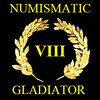Options
Ar vs Ag ... seriously ...
Before you dismiss this as a dumb question ... I've seen MANY numismatic sources using "AR" to indicate silver. I actually never noticed until recently, while browsing an Ancients dealer's website - so perhaps this is a new fad?
My question is why? The correct abbreviation for silver (aka Argentum) is "Ag," yet so many auction sites and dealers are doing this it caused me to question my education! to the point where I actually GOOGLED it thinking I was crazy!
So what is the deal?
Two minor details:
(1) I posted this on the US forum as well, to see if their opinions would vary; sorry if this double strike offends
(2) the abbreviation "Ar" means Argon, which is a gas, so maybe you shouldn't use it for coins
My question is why? The correct abbreviation for silver (aka Argentum) is "Ag," yet so many auction sites and dealers are doing this it caused me to question my education! to the point where I actually GOOGLED it thinking I was crazy!
So what is the deal?

Two minor details:
(1) I posted this on the US forum as well, to see if their opinions would vary; sorry if this double strike offends
(2) the abbreviation "Ar" means Argon, which is a gas, so maybe you shouldn't use it for coins
0

Comments
Amat Colligendo Focum
Top 10 • FOR SALE
Sounded good to me, theoretically, except I think the coin dealer practice of using the "AR" abbreviation may antedate the modern grading nomenclature which includes AG. And the numismatic "AR" abbreviation is used in countries where the AG grade doesn't exist.
So who knows. It's tradition. Like the 70-point Sheldon scale, it doesn't always make perfect sense.
<< <i>Traditional, esp I think for ancients: AR is for latin argentum, AE for Aes, etc. BTW, I've always seen it in caps only: AR, AE, AV. >>
Yes, exactly. The AV is from the Latin word for gold, "aurum", which of course would have been spelled "avrvm" in old Latin.
https://www.civitasgalleries.com
New coins listed monthly!
Josh Moran
CIVITAS Galleries, Ltd.
Amat Colligendo Focum
Top 10 • FOR SALE
The symbols "AV" for gold and "AR" for silver (note that both letters are always supposed to be capitalized, whereas with chemical symbols only the first letter is capitalized) are the symbols used by historians and archaeologists to describe the composition of objects. Historically, the symbols were ligatures, but this form of the usage has largely died out as ligatures for AR and AV are not even in extended Unicode, as far as I can tell. These symbols are not "new", as you seem to think; they have been used by numismatists since the dawn of the hobby, long before "America" ever existed as a country. You can find them used in all the old numismatic reference works. Here's an example from Google Books, from a coin catalogue published in 1834; the line-drawings of coins are labelled AE, AR or AV (all ligatured).
In other words, "AR" is not the new, upstart symbol for silver; "Ag" is. We coin collectors thought of "AR" first. It's not our fault the scientists went and changed the symbol on us.
Roman emperor Marcus Aurelius, "Meditations"
Apparently I have been awarded the DPOTD twice.
Well, that is Krause after all so take it for what it's worth.
Excellent detailed explanation of the why, Sapyx.
Interesting how nomenclature seems to change over time. When I first started doing banknotes, it was face and back and use of obverse and reverse was the mark of (most charitably) a newby. With more shiny disk folks getting into paper, obverse and reverse is really taking hold altho I still find the use somewhat jarring. Stuff changes.
As times change and language evolves - and alchemy becomes science - so do our symbols change. Apparently not for ancients.
I don't know why "America" came into the discussion but since you brought it up, the American flag has changed many times. But you don't see anyone hanging the first incarnation, do you? Now somebody post a photo of a colonial flag waving and prove me wrong
Amat Colligendo Focum
Top 10 • FOR SALE
And hey ...
Amat Colligendo Focum
Top 10 • FOR SALE
<< <i>Your welcome... The double post was an accident but glad it appeared to have a greater impact being posted twice .
"Inspiration exists, but it has to find you working" Pablo Picasso
Amat Colligendo Focum
Top 10 • FOR SALE